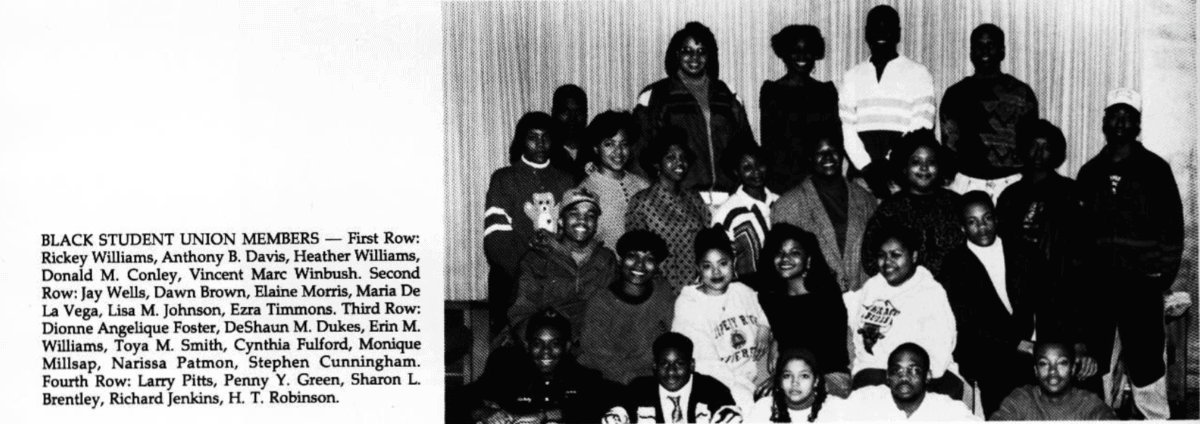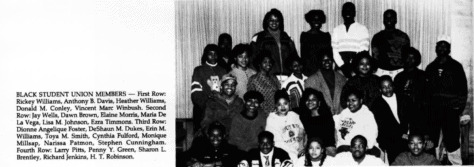
The 1990s
WASHINGTON, PA (March 11, 2021)—The 90s were a time for getting the groove back—which is exactly what the W&J Black Student Union did.
There was a renewed interest in cultural representation on campus, first heralded by Will Thomas’s ’91 organization CASE (Cultural Awareness Support Enrichment group) in the late 80s.
“When I came to W&J, there was a total of eight black students on campus: two in my class, and six spread out over the sophomore, junior and senior classes. The fact that there were so few of us was noticeable,” Thomas said. “I started thinking we have to form a coalition because there’s so few of us.”
Though at the time Will was unaware of the challenges faced by the group of Black students in the 70s, he knew that stacking the deck with more students would stand in his favor, and so he formed CASE, representing not only Black students on campus, but other non-white students, including a small cohort of Japanese exchange students.
The following year, though, more black students arrived on campus, with some feeling the blanket organization CASE was not enough; they wanted a Black Student Union. Leading the charge was freshman Cynthia Fulford ’93.
“CASE was too diluted, and didn’t focus on the African American culture and what we wanted,” Fulford said. “I’m an actualizer. I make things happen. I make space and make an environment that’s enjoyable for all—and that’s what I did there.”
Seeing that the push for a BSU would likely make the Student Government Association question the purpose of an organization like CASE—which they might view as offering the same type of benefit—Will agreed to help with the creation of the BSU and drafted the bylaws and constitution for the organization, just as he had done for CASE. As Will predicted, the rise of the BSU did cause CASE to fade, but the organization had paved the way for the more specific representation of the new BSU.
Under Cynthia’s leadership, the BSU brought a sense of camaraderie and community for W&J’s Black students—one that lives on today.
“I had a community of people who were in the same situation. We created space to feel more comfortable in that institution and from it ultimately found great long existing friendships. Many of us continue to stay in contact. We made a commitment to help each other, graduate, get through and do whatever was necessary. We created a family that I would say created a lasting impact on some faculty who are still there,” she said.
The organization also was instrumental in bringing more Black students to campus. Through the introduction of their signature cultural event—a Black Greek organization step show—students from colleges across the Greater Pittsburgh area came to W&J, and they liked what they saw. Soon after, the BSU partnered with the Office of Admission to recruit.
“When I came in, there were 13 of us, the largest class of Black students that W&J had recruited at that point,” Cynthia said. “The following year, there were 20. During my senior year, there were 75 African American students on campus. It was the increase of our presence on campus, including in athletics, where we were given the opportunity to make our presence known. We had Trina Fullard become Homecoming Queen, our men’s basketball team had 5 starters from our community and our football team had members who all helped contribute to the W&J journey of inclusion by winning championships.”
Though the challenges weren’t over after the rebirth of the BSU, its lasting impact has allowed for growth and greater inclusion on the W&J campus, giving power to students even today.
About Washington & Jefferson College
Washington & Jefferson College, located in Washington, Pa., is a selective liberal arts college founded in 1781. Committed to providing each of its students with the highest-quality undergraduate education available, W&J offers a traditional arts and sciences curriculum emphasizing interdisciplinary study and independent study work. For more information about W&J, visit washjeff.dev, or call 888-W-AND-JAY.



